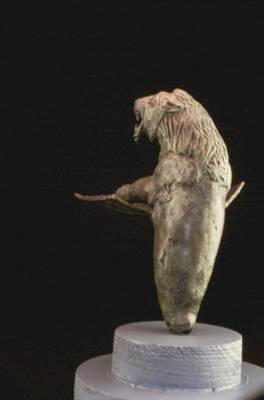A prototype of Hurrian civilization, Urkesh exhibits a number of peculiarities that may possibly be linked with a “Hurrian style”.
Four such stylistic traits are presented here.
Back to top: Experiments in style
Frontality
Hurrian art at Urkesh experiments with an innovative way to render the way in which the viewer aligns himself with the main axis of a subject presented as a sculpture in the round.
Back to top: Experiments in style
Full frontality
| The lion of Tish-atal in the Louvre has the classical frontal posture that we find in all Sumerian sculpture in the round. There is a single axis along which the face, the body, the paws of the lion are aligned. The plaque and the stone tablet are also aligned in the same direction. |

|
Back to top: Experiments in style
Double frontality
| The lion of Tish-atal which is today in the Metropolitan has a posture which is quite in contrast with that of its twin in the Louvre. The face is aligned along an axis which is oblique to that of the body, the paws and the plaque. This creates a dynamism which is quite innovative for Syro-Mesopotamian sculpture in the round. |

|
Back to top: Experiments in style
Following the axes…
| To provide good photographic documentation of this double frontality, we offer here a sequence of views from all angles, rotating clockwise. As an experiment, the photographs you see here are of a copy of the Metropolitan lion. As the lion turns, ask yourself which is the main axis? [The sequence of photographs was taken by Armand J. Fulco.] |






|
Back to top: Experiments in style
Movement
| Double frontality suggests a remarkable dynamism. But the quest for movement is realised in many other ways in the art of Urkesh. | 
A plowman pushing the plow into the furrow |
Back to top: Experiments in style
The seal of Ishar-beli
| Note the sharp contrast between the diagonal lines of the two animals (the buffalo looking up and the equid prancing) and the static vertical lines of the seated and the two standing deities. |


|
Back to top: Experiments in style
Circularity
| Another realization of movement is the strong circularity evident in two scenes... | |
| The reverse of the plowman stele, showing a herd revolving around an ideal central pivot. |

|
| A seal impression showing another herd in circular movement, with a bolder attempt at rendering perspective as well as movement. |


|
Back to top: Experiments in style
Descriptive details
| The Urkesh artists are very attentive to details that clearly define the setting of a scene. We see this in two scenes: | |
| The seal of the queen's cook, which describes a scene in the kitchen. |

|
| A stone plaque where we identify the two figures as Gilgamesh and Enkidu, as they get ready to go on their adventure against Huwawa. |


|
Back to top: Experiments in style